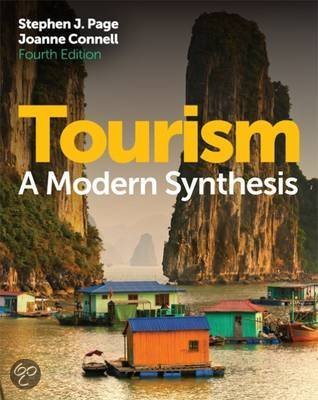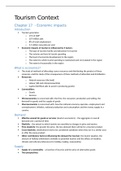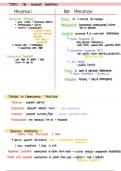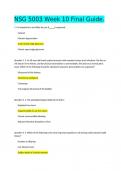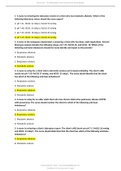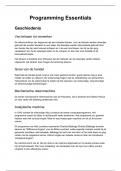Tourism Context
Chapter 17 - Economic impacts
Introduction
Tourism generates:
o 11% of GDP
o 207 million jobs
o 8% of total employment
o 5,5 million new jobs per year
Economic impacts of tourism is influenced by 5 factors:
o The type of tourism facility and attraction for tourists
o The volume and level of tourist spending
o The level of economic development in the region
o The extent to which tourist spending is maintained and recirculated in the region
o The extent of seasonality in the region
What is economics?
The study of methods of allocating scarce resources and distributing the product of those
resources, and the study of the consequences of these methods of allocation and distribution
Resources:
o Natural resources (the land)
o Labour (HR and entrepreneurship)
o Capital (Artificial aids to assist in producing goods)
Commodities:
o Goods
o Services
Microeconomics is concerned with: the firm, the consumer, production and selling, the
demand for goods and the supply of goods
Macroeconomics is concerned with: how the national economy operates, employment and
unemployment, inflation, national production and consumption and the money supply in a
country
Demand
Effective emend for goods or services (tourism economics) – the aggregate or overall
demand over a period of time
Elasticity – the extent to which tourists are sensitive to changes in price and service
Price elasticity: the greater the price, the less demand there will be for a tourism product
Cross-elasticity: destinations tend to be considered substitute when they are in a similar area
or offer the same product
Other contributory factors influencing the demand for tourism: the tourist taxation, the
amount of holiday entitlement available to potential tourists and the effects of weather,
climate and cultural preferences for holiday-making (seasonality)
Supply
Supply of a commodity – a function of its price and the price of alternative goods
Two perspectives:
, o Increasing demand requires an increase in facilities and infrastructure to cope with
added pressure – this centers of extending capacity
o Tourism may be stimulated by the provision of more facilities – this is creation
and/or anticipation of demand
The economic characteristics of the tourism industry
Characteristics of tourism which distinguish it from other industries, goods and services:
o Tourism is an invisible export industry – there is no tangible product and consumers
tend to make a purchase without seeing the product first-hand
o Tourists require supporting goods and services – the expansion of existing
infrastructure and services may be required or new ones created
o Tourism is a fragmented product – it consists of a number of elements, such as
transport and accommodation as well as landscape and cultural resources
o Tourism is a highly price- and income- elastic product
o Tourism is a perishable product – of a hotel room is not booked one night, then that
income is lost
o Tourism is subject to unpredictable external influences – currency, politics, tourist
motivation and taste
The demand for tourism is governed by 3 economic cycles
Short-term economic cycles
Periods of dramatic change
Highly visible and predictable, e.g. seasonality
Medium-term economic cycles
Changes over a period of several years
Tend to reflect consumer attitudes and the demand for specific tourism products
Also natural events (floods, hurricanes and earthquakes)
Economic crisis, currency devaluation etc.
Long-term economic cycles
Evolutionary process over a longer period of time
The tourism area lifecycle
Economic benefits
Balance of payments (for a country) – a record of transactions during a period of time
between residents of that country and the rest of the world (zestawienie wszystkich
transakcji dokonanych między rezydentami a nierezydentami w danym okresie
sprawozdawczym)
o Contribution of tourism to the overall balance : difference between the amount spent
by overseas visitors in that country and the amount spent overseas by residents of
the country (=>positive/negative account)
Income
o GDP – Gross Domestic Product
o Tourism can lead to increase of GDP
Employment
o Direct employment – jobs created as a result of visitor expenditure and directly
supporting tourism activity, e.g. hotels
, o Indirect employment – jobs created within the tourism supply sector but not as a
direct result of tourism activity, e.g. restaurants
o Induced employment – jobs created as a result of tourism expenditure as local
residents spend money earned from tourism
Visitor payback – visitor donations or voluntary levies imposed on tourist products and
services, used to fund conservation initiatives in visitor destinations
Economic costs
Inflation
o Tourism development -> inflationary effects on local economies, relating to land,
property and goods (Increased demand for land – increased price)
Opportunity costs
o Time, effort and money of developing tourism at the expense of other activities or
areas of investment (Government invests in tourism – the money spent is unavailable
for other uses)
Dependency
o Heavy reliance on a single industry
o Concentration Index – used to identify the level of dependency on one or more
generating countries:
Tourist arrivals¿ primary markets ¿ ×100
Alltourist arrivals
o It is more favorable for a destination to attract a broad base of tourists so that if
there is a downturn in one particular market then the consequences are not so
damaging
Seasonality
o Profits that have to be made in a shorter time period than in most industries and
spread across the year may not seem as lucrative as imagine
Leakage
o The money which flows out of the local or national tourism economy during its
circulation and spending by tourists on goods and services imported from outside the
economic system
o May occur through:
Repatriation of profits generated from foreign capital investment
Vertical integration
Not sourcing services and goods locally
Ownership of transport (e.g. the national airline)
o Well-developed destinations -> lowest leakage rates (they contain supply industries
which can compete with foreign imports)
o Tourism multiplier – a technique or subnational plan for tourism, which includes an
assessment of demand, supply, forecast, strategic issues and implementation
measures
In less developed countries cannot develop to its full potential because of
leakage
Income and employment
o Better paid, managerial posts may not be available to local people
o The income generated by tourism activity may not benefit the poorest in a society
Chapter 17 - Economic impacts
Introduction
Tourism generates:
o 11% of GDP
o 207 million jobs
o 8% of total employment
o 5,5 million new jobs per year
Economic impacts of tourism is influenced by 5 factors:
o The type of tourism facility and attraction for tourists
o The volume and level of tourist spending
o The level of economic development in the region
o The extent to which tourist spending is maintained and recirculated in the region
o The extent of seasonality in the region
What is economics?
The study of methods of allocating scarce resources and distributing the product of those
resources, and the study of the consequences of these methods of allocation and distribution
Resources:
o Natural resources (the land)
o Labour (HR and entrepreneurship)
o Capital (Artificial aids to assist in producing goods)
Commodities:
o Goods
o Services
Microeconomics is concerned with: the firm, the consumer, production and selling, the
demand for goods and the supply of goods
Macroeconomics is concerned with: how the national economy operates, employment and
unemployment, inflation, national production and consumption and the money supply in a
country
Demand
Effective emend for goods or services (tourism economics) – the aggregate or overall
demand over a period of time
Elasticity – the extent to which tourists are sensitive to changes in price and service
Price elasticity: the greater the price, the less demand there will be for a tourism product
Cross-elasticity: destinations tend to be considered substitute when they are in a similar area
or offer the same product
Other contributory factors influencing the demand for tourism: the tourist taxation, the
amount of holiday entitlement available to potential tourists and the effects of weather,
climate and cultural preferences for holiday-making (seasonality)
Supply
Supply of a commodity – a function of its price and the price of alternative goods
Two perspectives:
, o Increasing demand requires an increase in facilities and infrastructure to cope with
added pressure – this centers of extending capacity
o Tourism may be stimulated by the provision of more facilities – this is creation
and/or anticipation of demand
The economic characteristics of the tourism industry
Characteristics of tourism which distinguish it from other industries, goods and services:
o Tourism is an invisible export industry – there is no tangible product and consumers
tend to make a purchase without seeing the product first-hand
o Tourists require supporting goods and services – the expansion of existing
infrastructure and services may be required or new ones created
o Tourism is a fragmented product – it consists of a number of elements, such as
transport and accommodation as well as landscape and cultural resources
o Tourism is a highly price- and income- elastic product
o Tourism is a perishable product – of a hotel room is not booked one night, then that
income is lost
o Tourism is subject to unpredictable external influences – currency, politics, tourist
motivation and taste
The demand for tourism is governed by 3 economic cycles
Short-term economic cycles
Periods of dramatic change
Highly visible and predictable, e.g. seasonality
Medium-term economic cycles
Changes over a period of several years
Tend to reflect consumer attitudes and the demand for specific tourism products
Also natural events (floods, hurricanes and earthquakes)
Economic crisis, currency devaluation etc.
Long-term economic cycles
Evolutionary process over a longer period of time
The tourism area lifecycle
Economic benefits
Balance of payments (for a country) – a record of transactions during a period of time
between residents of that country and the rest of the world (zestawienie wszystkich
transakcji dokonanych między rezydentami a nierezydentami w danym okresie
sprawozdawczym)
o Contribution of tourism to the overall balance : difference between the amount spent
by overseas visitors in that country and the amount spent overseas by residents of
the country (=>positive/negative account)
Income
o GDP – Gross Domestic Product
o Tourism can lead to increase of GDP
Employment
o Direct employment – jobs created as a result of visitor expenditure and directly
supporting tourism activity, e.g. hotels
, o Indirect employment – jobs created within the tourism supply sector but not as a
direct result of tourism activity, e.g. restaurants
o Induced employment – jobs created as a result of tourism expenditure as local
residents spend money earned from tourism
Visitor payback – visitor donations or voluntary levies imposed on tourist products and
services, used to fund conservation initiatives in visitor destinations
Economic costs
Inflation
o Tourism development -> inflationary effects on local economies, relating to land,
property and goods (Increased demand for land – increased price)
Opportunity costs
o Time, effort and money of developing tourism at the expense of other activities or
areas of investment (Government invests in tourism – the money spent is unavailable
for other uses)
Dependency
o Heavy reliance on a single industry
o Concentration Index – used to identify the level of dependency on one or more
generating countries:
Tourist arrivals¿ primary markets ¿ ×100
Alltourist arrivals
o It is more favorable for a destination to attract a broad base of tourists so that if
there is a downturn in one particular market then the consequences are not so
damaging
Seasonality
o Profits that have to be made in a shorter time period than in most industries and
spread across the year may not seem as lucrative as imagine
Leakage
o The money which flows out of the local or national tourism economy during its
circulation and spending by tourists on goods and services imported from outside the
economic system
o May occur through:
Repatriation of profits generated from foreign capital investment
Vertical integration
Not sourcing services and goods locally
Ownership of transport (e.g. the national airline)
o Well-developed destinations -> lowest leakage rates (they contain supply industries
which can compete with foreign imports)
o Tourism multiplier – a technique or subnational plan for tourism, which includes an
assessment of demand, supply, forecast, strategic issues and implementation
measures
In less developed countries cannot develop to its full potential because of
leakage
Income and employment
o Better paid, managerial posts may not be available to local people
o The income generated by tourism activity may not benefit the poorest in a society


